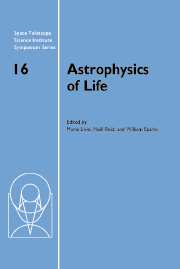 Astrophysics of Life
Astrophysics of Life Published online by Cambridge University Press: 29 August 2009
It is becoming increasingly clear, based on a combination of observational, theoretical, and laboratory studies, that the interstellar medium (ISM) is not chemically “inert.” Instead, it contains a variety of distinct environments in which chemical synthesis and alteration are constantly occurring under the aegis of a number of different processes. The result of these different processes is an interstellar medium rich in chemical diversity. The discussion found here will concentrate on those materials and molecular species built from the elements C, H, O, and N, with particular emphasis on those compounds that may be of prebiotic interest. Furthermore, there is excellent evidence that the products of interstellar chemistry are not restricted solely to the ISM, but that some fraction of these materials survive the transition from interstellar dense clouds to planetary surfaces when new stars and planets form in these clouds. This raises the interesting possibility that molecules created in the interstellar medium may play a role in the origin and evolution of life on planetary surfaces.
Introduction
A variety of organic and volatile compounds are now known or suspected to exist in a number of different space environments including stellar outflows, the diffuse interstellar medium, dense molecular clouds, and protostellar nebulae.
To save this book to your Kindle, first ensure [email protected] is added to your Approved Personal Document E-mail List under your Personal Document Settings on the Manage Your Content and Devices page of your Amazon account. Then enter the ‘name’ part of your Kindle email address below. Find out more about saving to your Kindle.
Note you can select to save to either the @free.kindle.com or @kindle.com variations. ‘@free.kindle.com’ emails are free but can only be saved to your device when it is connected to wi-fi. ‘@kindle.com’ emails can be delivered even when you are not connected to wi-fi, but note that service fees apply.
Find out more about the Kindle Personal Document Service.
To save content items to your account, please confirm that you agree to abide by our usage policies. If this is the first time you use this feature, you will be asked to authorise Cambridge Core to connect with your account. Find out more about saving content to Dropbox.
To save content items to your account, please confirm that you agree to abide by our usage policies. If this is the first time you use this feature, you will be asked to authorise Cambridge Core to connect with your account. Find out more about saving content to Google Drive.